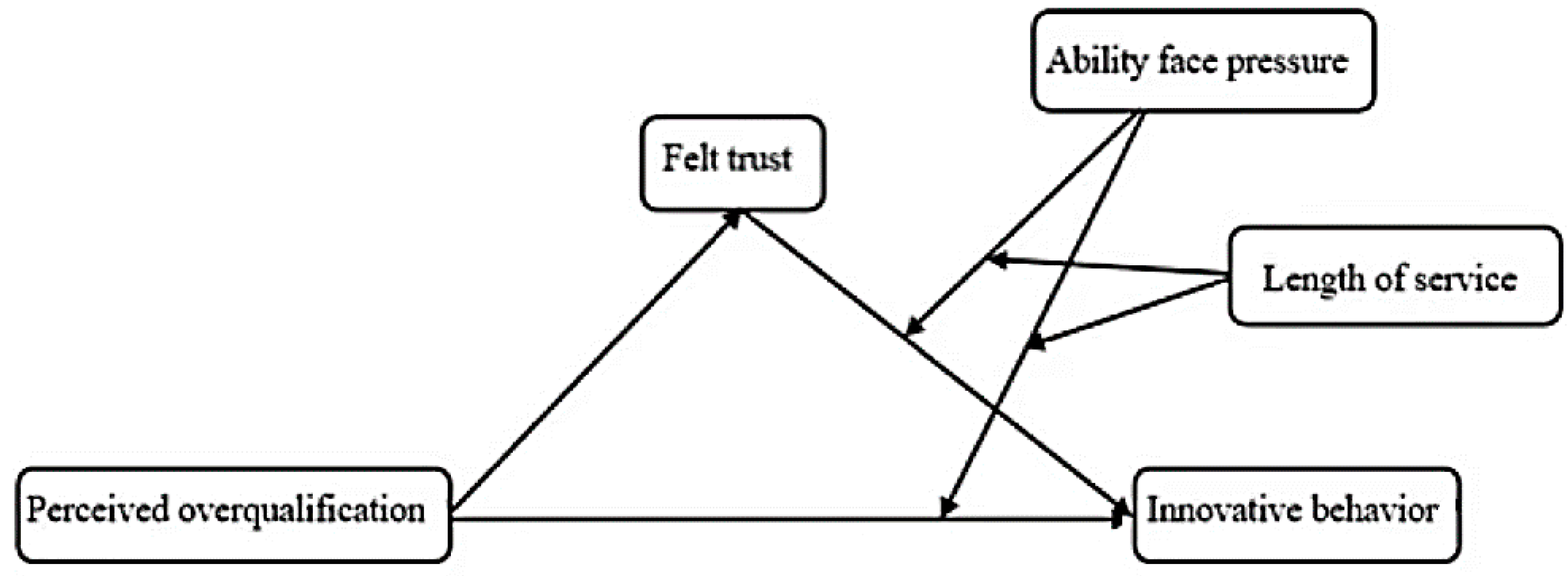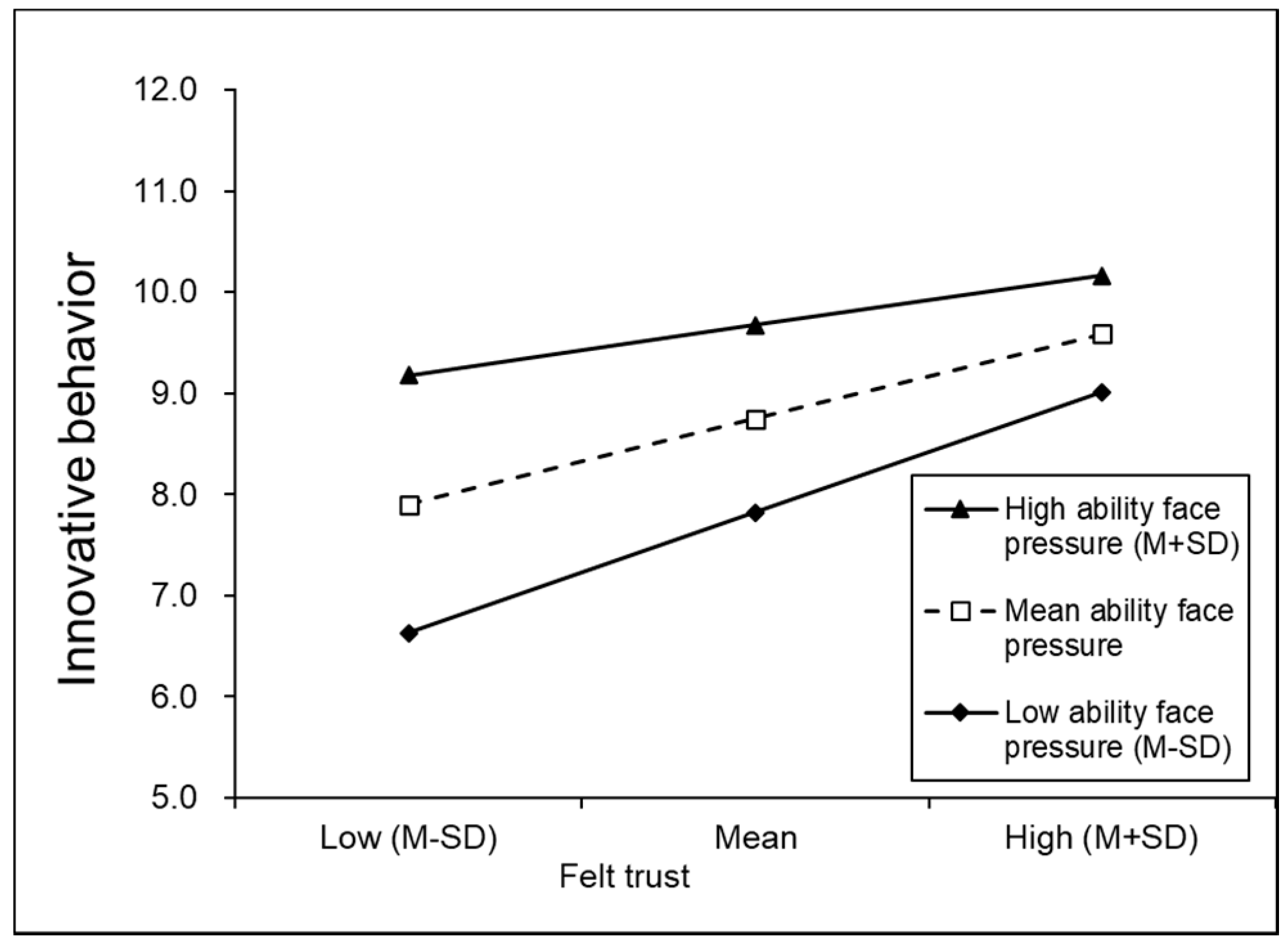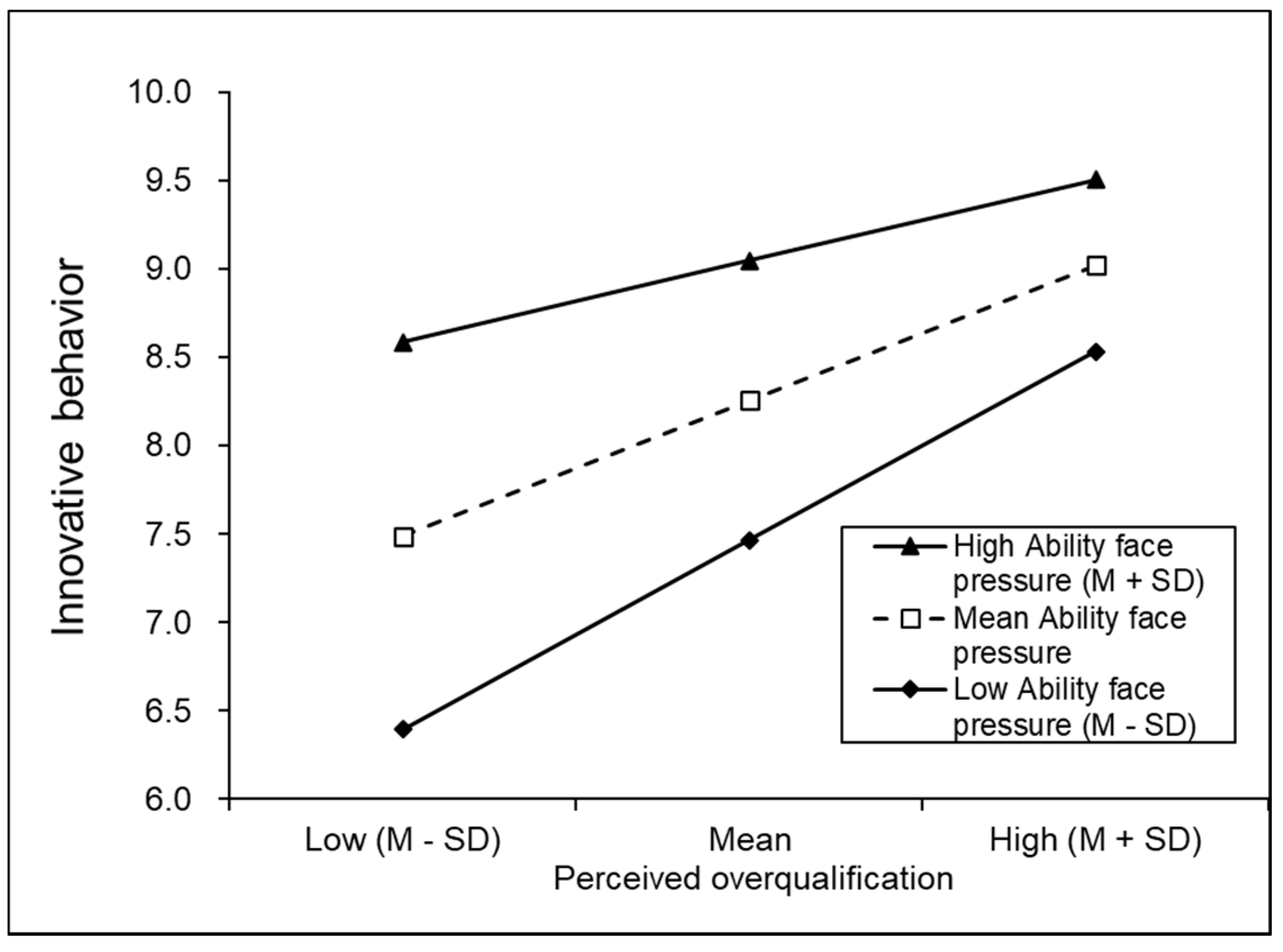Perceived Overqualification and Innovative Behavior: High-Order Moderating Effects of Length of Service
Abstract
:1. Introduction
2. Literature Review and Theoretical Framework
2.1. Perceived Overqualification and Innovative Behavior
2.2. Mediating Effect on Perceived Overqualification and Innovative Behavior
Felt Trust
2.3. The Moderating Effect of Ability Face Pressure
Ability Face Pressure
2.4. Synergistic Moderating Effect of Length of Service on Ability Face Pressure
Length of Service
3. Research Methods and Materials
3.1. Research Subjects and Data Collection
3.2. Measurement Scales
3.3. Reliability and Validity
4. Results
4.1. Descriptive Statistics and Correlation Analysis
4.2. Hypotheses Testing
5. Discussion and Conclusions
5.1. Discussion
5.2. Theoretical Contributions
5.3. Managerial Implications
5.4. Limitations and Future Research
Author Contributions
Funding
Institutional Review Board Statement
Informed Consent Statement
Data Availability Statement
Conflicts of Interest
References
- Zhang, R. Perceived Overqualification: A Literature Review. Front. Econ. Manag. 2021, 2, 256–263. [Google Scholar]
- Lou, T.; Ye, M. Studying on the Impact of Perceived Overqualification on Work Engagement: The Moderating Role of Future Work Self Salience and Mediating Role of Thriving at Work. Open J. Soc. Sci. 2019, 07, 24–36. [Google Scholar] [CrossRef] [Green Version]
- Maynard, D.C.; Parfyonova, N.M. Perceived overqualification and withdrawal behaviours: Examining the roles of job attitudes and work values. J. Occup. Organ. Psychol. 2013, 86, 435–455. [Google Scholar] [CrossRef]
- Yeves, J.; Bargsted, M.; Cortes, L.; Merino, C.; Cavada, G. Age and Perceived Employability as Moderators of Job Insecurity and Job Satisfaction: A Moderated Moderation Model. Front. Psychol. 2019, 10, 799–810. [Google Scholar] [CrossRef] [Green Version]
- Khan, M.I.; Mughal, Y.H.; Khattak, S.R. Buffering effect of perceived organizational support on the relationship between perceived overqualification and job satisfaction. J. Manag. 2019, 13, 162–169. [Google Scholar]
- Lin, B.; Law, K.S.; Zhou, J. Why Is Underemployment Related to Creativity and OCB? A Task Crafting Explanation of the Curvilinear Moderated Relations. Acad. Manag. J. 2017, 60, 156–177. [Google Scholar] [CrossRef]
- Ma, C.; Chen, G.Z.X.; Jiang, X. Give full play to the talent: Exploring when perceived overqualification leads to more altruistic helping behavior through extra effort. Pers. Rev. 2021. ahead-of-print. [Google Scholar] [CrossRef]
- Liu, S.W.M. Perceived overqualification: A review and recommendations for research and practice. Res. Occup. Stress Well Being 2012, 10, 1–42. [Google Scholar]
- Rink, F.; Kane, A.A.; Ellemers, N.; Vegt, G.V.D. Team Receptivity to Newcomers: Five Decades of Evidence and Future Research Themes. Acad. Manag. Ann. 2013, 7, 247–293. [Google Scholar] [CrossRef]
- RL, C.; KT, D.; AP, K.C.C.; SL, R. On the relation between felt trust and actual trust: Examining pathways to and implications of leader trust meta-accuracy. J. Appl. Psychol. 2020, 105, 994–1012. [Google Scholar]
- Fulmer, C.A.; Ostroff, C. Trust in direct leaders and top leaders: A trickle-up model. J. Appl. Psychol. 2017, 102, 648–657. [Google Scholar] [CrossRef] [PubMed]
- Jong, B.; Dirks, K.; Gillespie, N. Trust and team performance: A metaanalysis of main effects, moderators, and covariates. J. Appl. Psychol. 2016, 101, 1134–1150. [Google Scholar] [CrossRef] [PubMed] [Green Version]
- Lau, D.C.; Lam, L.W.; Wen, S.S. Examining the effects of feeling trusted by supervisors in the workplace: A self-evaluative perspective. J. Organ. Behav. 2014, 35, 112–127. [Google Scholar] [CrossRef]
- Heo, M.; Toomey, N.; Song, J.S. Self-evaluation of knowledge sharing through the lens of social comparison theory. VINE J. Inf. Knowl. Manag. Syst. 2019. ahead-of-print. [Google Scholar] [CrossRef]
- Xu, M.; Qin, X.; Dust, S.B.; Direnzo, M.S. Supervisor-subordinate proactive personality congruence and psychological safety: A signaling theory approach to employee voice behavior. Leadersh. Q. 2019, 30, 440–453. [Google Scholar] [CrossRef]
- Yao, J.; Zhang, Z.X.; Brett, J.M. Understanding trust development in negotiations: An interdependent approach. J. Organ. Behav. 2017, 38, 712–729. [Google Scholar] [CrossRef]
- Riana, G.I. Managing Work Family Conflict and Work Stress through Job Satisfaction and Its Impact on Employee Performance. J. Tek. Ind. 2019, 20, 127. [Google Scholar]
- Ma, B.; Hu, B.; Hou, Y. The U type effect of perceived overqualification on employee creativity–The mediation role of ability face pressure. Nankai Manag. Rev. 2018, 21, 150–161. [Google Scholar]
- Babo, G.P.K.L. The Influence of a Principal’s Length of Service on Elementary School Academic Performance: A Study of One Northeastern USA State. Int. Stud. Educ. Adm. 2017, 45, 117–130. [Google Scholar]
- Lee, A.; Erdogan, B.; Tian, A.W.; Willis, S.; Cao, J. Perceived overqualification and task performance: Reconciling two opposing pathways. J. Occup. Organ. Psychol. 2020, 94, 80–106. [Google Scholar] [CrossRef]
- Lee, W.R.; Choi, S.B.; Kang, S.W. How Leaders’ Positive Feedback Influences Employees’ Innovative Behavior: The Mediating Role of Voice Behavior and Job Autonomy. Sustainability 2021, 13, 1901. [Google Scholar] [CrossRef]
- Erdogan, B.; Bauer, T.N.; PEIRó, J.M.; Truxillo, D.M. Overqualified Employees: Making the Best of a Potentially Bad Situation for Individuals and Organizations. Ind. Organ. Psychol. 2011, 4, 215–232. [Google Scholar] [CrossRef]
- Russell, Z.A.; Ferris, G.R.; Thompson, K.W.; Sikora, D.M. Overqualified human resources, career development experiences, and work outcomes: Leveraging an underutilized resource with political skill. Hum. Resour. Manag. Rev. 2016, 26, 125–135. [Google Scholar] [CrossRef]
- Luksyte, A.; Spitzmueller, C. When Are Overqualified Employees Creative? It Depends on Contextual Factors. J. Organ. Behav. 2016, 37, 635–653. [Google Scholar] [CrossRef]
- Deng, H.; Guan, Y.; Wu, C.-H.; Erdogan, B.; Bauer, T.; Yao, X. A Relational Model of Perceived Overqualification: The Moderating Role of Interpersonal Influence on Social Acceptance. J. Manag. 2016, 44, 3288–3310. [Google Scholar] [CrossRef] [Green Version]
- Dar, N.; Ahmad, S.; Rahman, W. How and when overqualification improves innovative work behaviour: The roles of creative self-confidence and psychological safety. Pers. Rev. 2022. ahead-of-print. [Google Scholar] [CrossRef]
- Aslam, S.; Shahid, M.N.; Sattar, A. Perceived Overqualification as a Determinant of Proactive Behavior and Career Success: The Need for Achievement as a Moderator. J. Entrep. Manag. Innov. 2022, 4, 167–187. [Google Scholar] [CrossRef]
- Baer, M.; Dhensa-Kahlon, R.; Colquitt, J.; Rodell, J.B.; Outlaw, R.; Long, D. Uneasy Lies the Head that Bears the Trust: The Effects of Feeling Trusted on Emotional Exhaustion. Acad. Manag. J. 2015, 58, 1637–1657. [Google Scholar] [CrossRef] [Green Version]
- Brown, M. His, hers or theirs?: The majority High Court decision in Kennon and Spry means that family law courts can deal with trust arrangements in a far more robust way than in the past. Law Soc. J. Off. J. Law Soc. New South Wales 2009, 47, 60–63. [Google Scholar]
- Zhang, X.A.; Cao, Q.; Grigoriou, N. Consciousness of Social Face: The Development and Validation of a Scale Measuring Desire to Gain Face Versus Fear of Losing Face. J. Soc. Psychol. 2011, 151, 129–149. [Google Scholar] [CrossRef]
- Li, Z.; Zhao, S. A study on the relationship between organizational expected Contribution and employee creativity from the perspective of face. Chin. J. Manag. 2018, 15, 1799–1809. [Google Scholar] [CrossRef] [PubMed]
- Chang, T.; Liu, Z.; Wang, Y. The impact of performance-based pay on employee creativity Impact research: The mediating role of face pressure. Sci. Sci. Manag. Sci. Technol. 2014, 35, 171–180. (In Chinese) [Google Scholar]
- Bornay-Barrachina, M.; López-Cabrales, A.; Valle-Cabrera, R. How do employment relationships enhance firm innovation? The role of human and social capital. Int. J. Hum. Resour. Manag. 2017, 28, 1363–1391. [Google Scholar] [CrossRef]
- Mainemelis, C. Stealing fire: Creative deviance in the evolution of new ideas. Acad. Manag. Rev. 2010, 35, 558–578. [Google Scholar]
- Wiklund, J.; Yu, W.; Patzelt, H. Impulsivity and Entrepreneurial Action. Acad. Manag. Exec. 2018, 32, 379–403. [Google Scholar] [CrossRef]
- Hao, S.; Han, P.; Wu, C. The relationship between two dimensions of felt trust and promotive voice behaviour: The motivational mechanisms. J. Manag. Psychol. 2021. ahead-of-print. [Google Scholar] [CrossRef]
- Song, Y.; Peng, P.; Yu, G. I Would Speak Up to Live Up to Your Trust: The Role of Psychological Safety and Regulatory Focus. Front. Psychol. 2019, 10, 2966. [Google Scholar] [CrossRef] [Green Version]
- Stanetic, K.; Tesanovic, G. Influence of age and length of service on the level of stress and burnout syndrome. Med. Pregl. 2013, 66, 153–162. [Google Scholar] [CrossRef]
- Khorram-Manesh, A. The Impact of Experience, Length of Service, and Workplace Preparedness in Physicians’ Readiness in the Response to Disasters. J. Clin. Med. 2020, 9, 3328. [Google Scholar]
- Zhou, Y.; Huang, X.; Xie, W. Does feeling overqualified motivate employee voice behavior?—Based on the perspective of equity inspiration. Manag. Rev. 2020, 32, 193–203. [Google Scholar]
- Lestari, D.; Margaretha, M. Work life balance, job engagement and turnover intention: Experience from Y generation employees. Manag. Sci. Lett. 2021, 11, 157–170. [Google Scholar] [CrossRef]
- Ng, T.; Feldman, D. Affective organizational commitment and citizenship behavior: Linear and non-linear moderating effects of organizational tenure. J. Vocat. Behav. 2011, 79, 528–537. [Google Scholar] [CrossRef]
- Volmer, J.; Spurk, D.; Niessen, C. Leader-member exchange (LMX), job autonomy, and creative work involvement. Leadersh. Q. 2012, 23, 456–465. [Google Scholar] [CrossRef]
- Johnson, G.J.; Johnson, W.R. Perceived overqualification and psychological well-being. J. Soc. Psychol. 1996, 136, 435–445. [Google Scholar] [CrossRef]
- Sim, Y.; Lee, E.-S. Perceived underqualification and job attitudes: The role of transformational leadership. Leadersh. Organ. Dev. J. 2018, 39, 962–974. [Google Scholar] [CrossRef]
- Scott, S.G.; Bruce, R.A. Determinants of Innovative Behavior: A Path Model of Individual Innovation in the Workplace. Acad. Manag. J. 1994, 37, 580–607. [Google Scholar]
- Kang, J.H.; Matusik, J.G.; Kim, T.Y.; Phillips, J.M. Interactive effects of multiple organizational climates on employee innovative behavior in entrepreneurial firms: A cross-level investigation. J. Busi. Ventur. 2016, 31, 628–642. [Google Scholar] [CrossRef]
- Gillespie, N. Measuring Trust in Working Relationships: The Behavioral Trust Inventory. Seattle Acad. Manag. Conf. 2003, 14, 55. [Google Scholar]
- Hodgins, H.S.; Liebeskind, E. Apology versus defense: Antecedents and consequences. J. Exp. Soc. Psychol. 2003, 39, 297–316. [Google Scholar] [CrossRef]
- Wang, H. Help Seeking Tendency in Situation of Threat to Self-Esteem and Face-Losing. Ph.D. Dissertation, University of Hong Kong, Hong Kong, China, 2002. [Google Scholar]
- Zhao, J. A Study of the Effects of Interpersonal Conflict and Face-Saving within Teams on Team Creativity. Ph.D. Dissertation, Zhejiang University, Hangzhou, China, 2009. [Google Scholar]
- Lobene, E.V.; Meade, A. The Effects of Career Calling and Perceived Overqualification on Work Outcomes for Primary and Secondary School Teachers. J. Career Dev. 2013, 40, 508–530. [Google Scholar] [CrossRef]
- Fine, S.; Nevo, B. Too smart for their own good? A study of perceived cognitive overqualification in the workforce. Int. J. Hum. Resour. Manag. 2008, 19, 346–355. [Google Scholar] [CrossRef]
- Erdogan, B.; Tomas, I.; Valls, V.; Gracia, F.J. Perceived overqualification, relative deprivation, and personcentric outcomes: The moderating role of career centrality. J. Vocat. Behav. 2018, 107, 233–245. [Google Scholar] [CrossRef]
- Harari, M.B.; Manapragada, A.; Viswesvaran, C. Who thinks they’re a big fish in a small pond and why does it matter? A meta-analysis of perceived overqualification. J. Vocat. Behav. 2017, 102, 28–47. [Google Scholar] [CrossRef]
- Moore, J. Performative face theory: A critical perspective on interpersonal identity work. Commun. Monogr. 2017, 84, 258–276. [Google Scholar] [CrossRef]




| Constructs | Items | Factor Loadings | CR | |
|---|---|---|---|---|
| Perceived overqualification | PO1 | 0.667 | 0.706 | 0.7134 |
| PO2 | 0.551 | |||
| PO3 | 0.675 | |||
| PO4 | 0.581 | |||
| Felt trust | FT1 | 0.618 | 0.724 | 0.7308 |
| FT2 | 0.730 | |||
| FT3 | 0.717 | |||
| Innovative behavior | IB1 | 0.641 | 0.760 | 0.771 |
| IB2 | 0.645 | |||
| IB3 | 0.691 | |||
| IB4 | 0.661 | |||
| IB5 | 0.529 | |||
| Ability face pressure | AFP1 | 0.741 | 0.784 | 0.7924 |
| AFP2 | 0.688 | |||
| AFP3 | 0.748 | |||
| AFP4 | 0.614 |
| Model | CFI | TLI | IFI | RMSEA | |||
|---|---|---|---|---|---|---|---|
| Single factor | 521.900 | 101 | 5.167 | 0.549 | 0.464 | 0.558 | 0.138 |
| Two factor a | 483.698 | 100 | 4.837 | 0.589 | 0.507 | 0.598 | 0.132 |
| Two factor b | 306.464 | 100 | 3.065 | 0.779 | 0.735 | 0.783 | 0.097 |
| Three factor | 305.970 | 98 | 3.122 | 0.777 | 0.727 | 0.782 | 0.098 |
| Four factor | 155.868 | 95 | 1.641 | 0.935 | 0.918 | 0.937 | 0.054 |
| Variables | 1 | 2 | 3 | 4 | 5 | 6 | 7 | 8 | 9 | 10 |
|---|---|---|---|---|---|---|---|---|---|---|
| 1. Gender | 1 | |||||||||
| 2. Age | −0.135 * | 1 | ||||||||
| 3. Education level | −0.004 | −0.185 ** | 1 | |||||||
| 4. Type of enterprise | −0.032 | −0.243 ** | 0.001 | 1 | ||||||
| 5. Enterprise scale | −0.115 | 0.079 | 0.165 * | −0.081 | 1 | |||||
| 6. Perceived overqualification | −0.032 | 0.182 ** | −0.045 | −0.091 | 0.091 | (0.621) | ||||
| 7. Innovative behavior | 0.157 * | 0.068 | 0.101 | −0.129 | 0.122 | 0.351 ** | (0.636) | |||
| 8. Ability face pressure | −0.001 | 0.144 * | −0.066 | −0.132 | 0.036 | 0.237 ** | 0.204 ** | (0.700) | ||
| 9. Felt trust | 0.047 | −0.024 | 0.090 | −0.006 | 0.054 | 0.212 ** | 0.443 ** | 0.117 | (0.690) | |
| 10. Length of service | −0.048 | 0.644 ** | −0.135 * | −0.143 * | 0.049 | 0.172 * | 0.064 | 0.094 | 0.013 | 1 |
| Mean | 1.56 | 2.05 | 2.95 | 2.18 | 2.42 | 5.125 | 5.472 | 4.596 | 4.896 | 2.74 |
| Standard Deviation | 0.497 | 0.594 | 0.555 | 1.017 | 1.154 | 0.866 | 0.823 | 0.982 | 1.105 | 0.741 |
| Model | CFI | TLI | IFI | RMSEA | |||
|---|---|---|---|---|---|---|---|
| Theoretical model | 63.307 | 48 | 1.319 | 0.976 | 0.968 | 0.977 | 0.038 |
| Nested model | 69.755 | 49 | 1.424 | 0.968 | 0.957 | 0.969 | 0.044 |
| Alternative model | 82.767 | 49 | 1.689 | 0.948 | 0.930 | 0.949 | 0.056 |
| Variables | Innovative Behavior | ||||||
|---|---|---|---|---|---|---|---|
| M1 | M2 | M3 | M4 | M5 | M6 | ||
| Constant | 4.335 ** | 1.779 ** | −0.117 | −0.545 | 0.418 | 0.57 | |
| Control variables | Gender | 0.295 | 0.264 ** | 0.247 | 0.259 ** | 0.263 ** | 0.261 ** |
| Age | 0.109 | 0.057 | 0.08 | 0.055 | 0.039 | 0.065 | |
| Education level | 0.145 | 0.118 | 0.13 | 0.133 | 0.132 | 0.12 | |
| Type of enterprise | −0.077 | −0.060 | −0.036 | −0.031 | −0.047 | −0.050 | |
| Enterprise scale | 0.08 | 0.052 | 0.052 | 0.043 | 0.053 | 0.06 | |
| Main effect | Perceived overqualification | 0.231 ** | 0.612 ** | 0.189 ** | 0.205 ** | 0.353 ** | |
| Felt trust | 0.270 ** | 0.253 ** | 0.778 ** | 0.421 ** | 0.253 ** | ||
| Ability face pressure | 0.078 | 0.534 ** | 0.633 ** | 0.236 * | 0.219 * | ||
| Length of service | −0.015 | −0.032 | −0.035 | 0.257 | 0.223 | ||
| Double interaction | Perceived overqualification × ability face pressure | −0.090 * | |||||
| Felt trust × ability face pressure | −0.111 ** | ||||||
| Triple interaction | Perceived overqualification × ability face pressure × length of service | −0.012 * | |||||
| Felt trust × ability face pressure × length of service | −0.011 | ||||||
| F | 3.178 ** | 10.873 ** | 10.522 ** | 11.190 ** | 10.278 ** | 10.170 ** | |
| R2 | 0.047 | 0.289 | 0.303 | 0.318 | 0.298 | 0.295 | |
| ΔR2 | 0.249 ** | 0.017 * | 0.031 ** | 0.012 * | 0.009 | ||
| Variables | Felt Trust | ||||||
| M7 | M8 | ||||||
| Constant | 4.157 ** | 2.455 ** | |||||
| Control variables | Gender | 0.115 | 0.111 | ||||
| Age | −0.011 | −0.122 | |||||
| Education level | 0.162 | 0.183 | |||||
| Type of enterprise | −0.002 | 0.016 | |||||
| Enterprise scale | 0.045 | 0.027 | |||||
| Main effect | Perceived overqualification | 0.261 ** | |||||
| Felt trust | |||||||
| Ability face pressure | 0.093 | ||||||
| Length of service | 0.042 | ||||||
| Double interaction | Perceived overqualification × ability face pressure | ||||||
| Felt trust × ability face pressure | |||||||
| Triple interaction | Perceived overqualification × ability face pressure × length of service | ||||||
| Felt trust × ability face pressure × length of service | |||||||
| F | 0.538 | 1.894 | |||||
| R2 | 0.012 | 0.032 | |||||
| ΔR2 | 0.055 | ||||||
Publisher’s Note: MDPI stays neutral with regard to jurisdictional claims in published maps and institutional affiliations. |
© 2022 by the authors. Licensee MDPI, Basel, Switzerland. This article is an open access article distributed under the terms and conditions of the Creative Commons Attribution (CC BY) license (https://creativecommons.org/licenses/by/4.0/).
Share and Cite
Sun, Y.; Qiu, Z. Perceived Overqualification and Innovative Behavior: High-Order Moderating Effects of Length of Service. Sustainability 2022, 14, 3493. https://doi.org/10.3390/su14063493
Sun Y, Qiu Z. Perceived Overqualification and Innovative Behavior: High-Order Moderating Effects of Length of Service. Sustainability. 2022; 14(6):3493. https://doi.org/10.3390/su14063493
Chicago/Turabian StyleSun, Yongbo, and Zichen Qiu. 2022. "Perceived Overqualification and Innovative Behavior: High-Order Moderating Effects of Length of Service" Sustainability 14, no. 6: 3493. https://doi.org/10.3390/su14063493
APA StyleSun, Y., & Qiu, Z. (2022). Perceived Overqualification and Innovative Behavior: High-Order Moderating Effects of Length of Service. Sustainability, 14(6), 3493. https://doi.org/10.3390/su14063493





